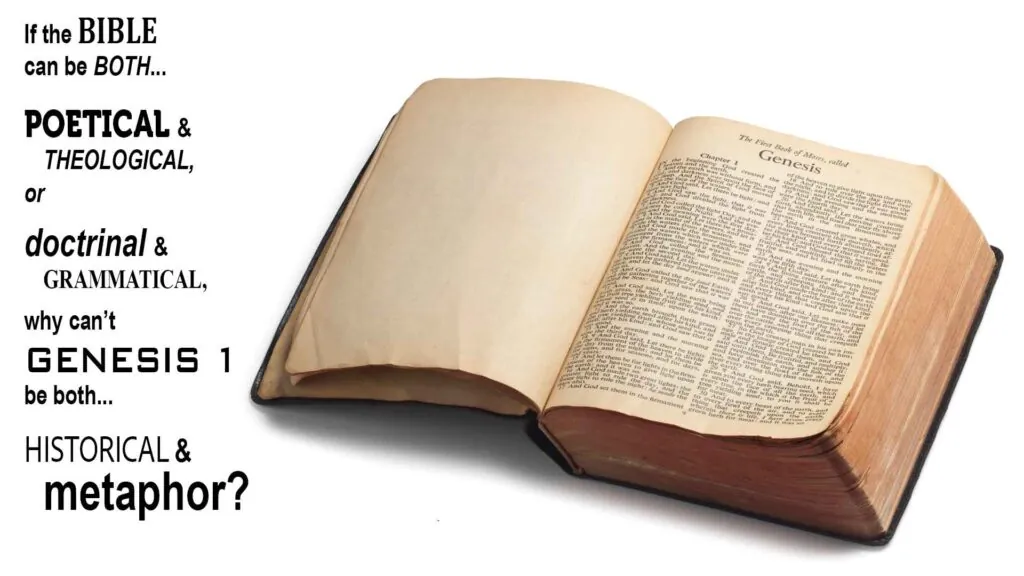Until recently, most Christians believed that the Bible teaches us that the earth was only a few thousand years ago. This contradicts mainstream science, which holds that the earth is billions of years old. Consequently, many Christians, have modified their reading of the Bible accordingly.
At first sight, this may seem rather harmless. The age of the earth hardly seems to be a doctrine essential to the Bible’s main message of salvation.
Yet, much more is at stake than first meets the eye.
Accepting mainstream science on the age of the earth entails that we accept the reliability of its dating methods, with all the underlying presumptions. It entails also that we should likewise accept other results of mainstream science that are based on similar assumptions.
Let’s see what this implies.
The order of creation
We note first that mainstream science challenges not only the timescale of the Genesis creation account but also its order.
Genesis 1 says:
- Day 1 – Water, earthly elements, then light
- Day 2 – Firmament, then oceans, atmosphere
- Day 3 – Dry land, then land vegetation, fruit trees, grass
- Day 4 – Sun, moon, stars
- Day 5 – Marine life, then birds
- Day 6 – Land animals, then humans
Mainstream science says:
- 14 billion years ago – light/light elements, then stars/galaxies, then heavy elements/water
- 4.58 billion years ago – Sun
- 4.54 billion years ago – earth
- 550 million years ago (mya) – first fish
- 440 mya – first primitive plants
- 360 mya – first land animals – reptiles
- 245 mya – first mammals
- 210 mya – first birds
- 140 mya – first flowering plants
- 70 mya – first grasses, fruit trees
- 2 mya – first tool-making humanoids
Note that the two orders differ at many places. For example, Genesis has fruit trees first, then birds, and then land animals; mainstream science has exactly the reverse. Genesis has the earth before the Sun and stars; mainstream science has stars and Sun before the earth, etc.
Since it does not help to simply recast the creation days as long periods of time, most commentators trying to accommodate mainstream science now advocate that Genesis 1 has to be taken as a purely literary structure, with no real historical information – other than stating that God created the entire universe.
The effect of the Fall
A second consequence concerns the Fall of Adam. Calvin (and Kuyper) believed that predation, death, disease, thorns, earthquakes all arose as a result of the Fall. Viewed in terms of the traditional reading of Genesis, the fossil record reflects events that all happened after the Fall.
Acceptance of an old earth, on the other hand, entails that the fossils we observe mostly reflect life before the Fall. Predation, pain, suffering, disease, earthquakes and the like, must then have existed already before the Fall. The fossil record, thus viewed, implies that the Fall did not have any observable effects on the earth or on non-human life. It follows that proponents of an old earth must minimize the physical consequences of Adam’s fall.
Traditionally, all animal suffering is seen as a result of human sin. But now it must be seen as part of the initial “very good” creation. Further, if the current world is not a world that has fallen from a better initial state, how can there be a universal restoration (cf Romans 8:19-23; Col. 1:16-20)?
There are other difficulties. For example, how could Adam name all the animals if by then more than 99% had already become extinct?
Human history
Consider further the implications for human history.
According to Genesis, Adam and Eve were created directly by God (Gen. 2) about 4000 BC (Gen. 5 & 11). They were the parents of all humans (Gen. 3:20). The Bible describes Adam as a gardener, his son Abel as a shepherd, and his son Cain as a farmer who founded a city (Gen. 4). Tents, musical instruments and bronze and iron tools were all invented by the offspring of Cain (Gen. 4), who were later all destroyed by the Flood (Gen. 6-9), which destroyed all humans except for Noah and his family (cf. 2 Pet. 2:5). Within a few generations after the Flood there is a confusion of language and people spread out to populate the earth (Gen. 11).
Mainstream science, on the other hand, gives the following outline of human history:
- 2 million years BC – homo erectus, anatomically very similar to modern man
- 200,000 BC – oldest anatomically human Homo sapiens fossils (Ethiopia)
- 40-50,000 BC – oldest artistic and religious artifacts
- 40,000 BC – first aborigines in Australia (and continuously there ever since).
- 9000 BC – first villages
- 7500 BC – first plant cultivation, domesticated cattle and sheep (neolithic era)
- 5000 BC – first bronze tools
- 3000 BC – first written records
- 1600 BC – first iron tools
The Biblical account is clearly at odds with the mainstream interpretation of the archaeological and fossil evidence.
For example, if Australian aborigines have indeed lived separately from the rest of the world for 40,000 years then the Flood, if anthropologically universal, must have occurred more than 40,000 years ago. But Genesis places the cultivation of plants and cattle, metal-working, cities, etc., before the Flood. Mainstream science places these events after 10,000 BC. Hence, according to mainstream science, Noah’s flood could not have occurred before 10,000 BC.
Consequently, an old earth position forces us to demote the Genesis flood to a local flood that did not affect all humans. Likewise, the tower of Babel incident (Gen.11) must now be localized to just a portion of mankind.
Consider also the origin of man. Since Adam’s sons were farmers, mainstream science sets the date of Adam no earlier than 10,000 BC. This entails that the Australian aborigines are not descendants of Adam. Thus Adam and Eve are not the ancestors of all humans living today. This undermines the doctrine of original sin, which the confessions say was propagated in a hereditary manner from Adam to all his posterity (Belgic Confession 15-16; Canons of Dordt 34:2-3). This, in turn, undermines the view of Christ’s atonement as a penal substitution where Christ, as a representative descendent of Adam, pays for the sins of Adam’s race. Many of those who accept an evolutionary view of man have thus re-interpreted the work of Jesus as merely an example of love.
Further, given the close similarity between human fossils of 10,000 and 2 million years ago, it becomes difficult to avoid concluding that Adam and Eve had human-like ancestors dating back a few million years. But that entails that Adam and Eve were not created directly by God, contrary to Gen. 2, and that human suffering and death occurred long before Adam’s fall, contrary to Rom. 5:12.
Conclusions
To sum up, embracing mainstream science regarding its assertion of an old earth entails the following consequences:
- Both the timescale and order of the creation account of Genesis 1 are wrong.
- The Flood of Gen. 6-8 must have been local, not affecting all humans.
- The Babel account of Gen. 11 must have been local, not affecting all humans.
- Adam’s fall – and the subsequent curse on the earth – did not significantly affect the earth, plants, animals, or the human body.
- Adam, living about 10,000 BC, could not have been the ancestor of all humans living today.
- Hence the doctrines of original sin and the atonement must be revised
- Adam had human ancestors
- Hence human physical suffering and death occurred before the Fall and are not a penalty for sin.
These, in turn, entail the following constraints on the Bible:
- 1-11 does not report reliable history.
- Hence the Bible cannot be taken at face value when describing historical events, in which case we cannot believe everything the Bible says (cf. Belgic Confession 5; Heidelberg CatechismQ/A 21).
In sum, acceptance of an old earth has dire consequences for the rest of Gen. 1-11, for Biblical clarity, authority and inerrancy, and for the essentials of salvation.
Worldviews come as package deals. One cannot simply mix and match. Logical consistency dictates that those who do not whole-heartedly base their worldview on the Bible will ultimately end up rejecting it.
A better course of action would thus be to hold fast to the full authority of the Bible, to re-consider the presuppositions leading to an old earth, and to interpret the data in terms of scientific theories that are consistent with Biblical truths.
This article first appeared in an Oct. 24, 2009 post on Dr. John Byl’s blog Bylogos.blogspot.com and is reprinted here with permission. Dr. John Byl is a Professor emeritus for Trinity Western University, and the author of “God and Cosmos: A Christian View of Time, Space, and the Universe” and “The Divine Challenge: On Matter, Mind, Math & Meaning.”











